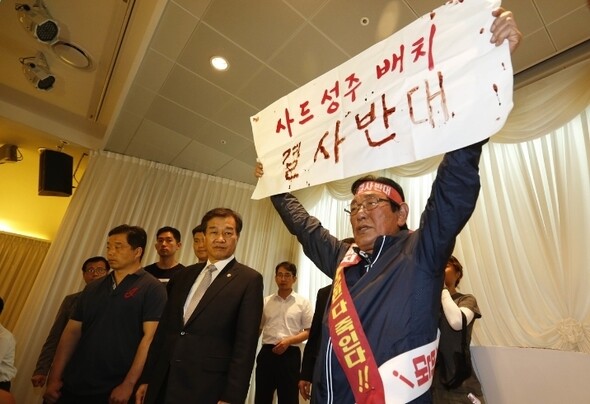hankyoreh
Links to other country sites 다른 나라 사이트 링크
[Editorial] The gov’t’s absurd claims that THAAD is meant to protect South Koreans

On July 13, the South Korean government announced earlier than planned that the THAAD missile defense system will be deployed in Seongju County in North Gyeongsang Province. As the backlash from Seongju residents intensifies, the government apparently concluded that delaying the announcement any longer would just make matters worse.
No small number of issues and inconsistencies are evident in the government’s decision to deploy THAAD and its announcement of the site where the system will be deployed.
After China and Russia strongly protested the decision to deploy THAAD, South Korea’s Defense Ministry argued that THAAD was unconnected with China and Russia and was intended to defend the South Korean public from North Korean nuclear weapons and missiles. If THAAD were deployed in South Korea, it could serve as a big umbrella that would defend a much wider area than Patriot missiles, the Ministry said.
But by selecting Seongju for deployment of the THAAD battery, the Defense Ministry contradicted its own argument. If THAAD is deployed in Seongju, Seoul and most of its suburbs will fall outside of THAAD’s 200km defense range. It is absurd for the Ministry to claim that it decided to deploy THAAD to protect the people from North Korean attacks when it leaves a densely populated area that is home to nearly half of South Koreans outside of THAAD’s defense range.
If THAAD is deployed in Seongju, the Seoul area will not be included in its protective range, while US military bases in Pyeongtaek, Osan, Gunsan, Daegu and Chilgok will be included.
The implications here are obvious: the campaign to deploy THAAD was purely organized and promoted by US interests, and THAAD is a system designed to defend the US military. Despite this, South Korea’s Defense Ministry has been claiming that the THAAD deployment is intended to keep South Koreans safe - which can only mean that it has been making fools of the South Korean people.
There is even speculation that it was decided to deploy THAAD to the south in order to keep the battery as far away from China as possible with the hope of avoiding a backlash from China. This means that the government cannot be taken seriously when it says that deploying THAAD is a self-defense measure reflecting South Korea’s sovereignty.
The way that the government announced the location where THAAD will be deployed was also unacceptable. It had originally been planning to announce this location at the same time that it announced the decision to deploy the system. But in the hurry to make the decision - and under pressure from the US - South Korea apparently postponed the announcement of the location.
The government had already made its final decision about where THAAD would be deployed. Despite this, it plunged the country into confusion by describing Chilgok as a contender and Yangsan as a suitable site, as if it were still filtering through the candidates. The government effectively pulled one over on the public.
The decision to deploy THAAD in Seongju has hit county residents like a bolt from the blue. The government is force-feeding residents claims about THAAD‘s safety, but this is hardly going to assuage concerns about the electromagnetic waves the system emits.
Furthermore, the site where THAAD is deployed is sure to be prime target for enemy forces if a war breaks out. It is completely normal for Seongju residents to be up in arms about the deployment. Their protests should not be discounted as just another “not in my backyard” protest.
The THAAD deployment has been all wrong from the very start, and it needs to be reconsidered from scratch. Doing otherwise will be sure to prolong the national schism and to exacerbate the debate about harm to the national interest.
Please direct questions or comments to [english@hani.co.kr]

Editorial・opinion
![[Column] Park Geun-hye déjà vu in Yoon Suk-yeol [Column] Park Geun-hye déjà vu in Yoon Suk-yeol](https://flexible.img.hani.co.kr/flexible/normal/500/300/imgdb/original/2024/0424/651713945113788.jpg) [Column] Park Geun-hye déjà vu in Yoon Suk-yeol
[Column] Park Geun-hye déjà vu in Yoon Suk-yeol![[Editorial] New weight of N. Korea’s nuclear threats makes dialogue all the more urgent [Editorial] New weight of N. Korea’s nuclear threats makes dialogue all the more urgent](https://flexible.img.hani.co.kr/flexible/normal/500/300/imgdb/original/2024/0424/7317139454662664.jpg) [Editorial] New weight of N. Korea’s nuclear threats makes dialogue all the more urgent
[Editorial] New weight of N. Korea’s nuclear threats makes dialogue all the more urgent- [Guest essay] The real reason Korea’s new right wants to dub Rhee a founding father
- [Column] ‘Choson’: Is it time we start referring to N. Korea in its own terms?
- [Editorial] Japan’s rewriting of history with Korea has gone too far
- [Column] The president’s questionable capacity for dialogue
- [Column] Are chaebol firms just pizza pies for families to divvy up as they please?
- [Column] Has Korea, too, crossed the Rubicon on China?
- [Correspondent’s column] In Japan’s alliance with US, echoes of its past alliances with UK
- [Editorial] Does Yoon think the Korean public is wrong?
Most viewed articles
- 1[Column] Park Geun-hye déjà vu in Yoon Suk-yeol
- 2Thursday to mark start of resignations by senior doctors amid standoff with government
- 3N. Korean hackers breached 10 defense contractors in South for months, police say
- 4Kim Jong-un expressed ‘satisfaction’ with nuclear counterstrike drill directed at South
- 5[Editorial] New weight of N. Korea’s nuclear threats makes dialogue all the more urgent
- 6Will NewJeans end up collateral damage in internal feud at K-pop juggernaut Hybe?
- 7[Column] ‘Choson’: Is it time we start referring to N. Korea in its own terms?
- 8[Editorial] Japan’s rewriting of history with Korea has gone too far
- 9[Cine feature] A new shift in the Korean film investment and distribution market
- 10[Column] The president’s questionable capacity for dialogue